Dee Estuary Birding
Monthly Newsletter...
October 2021 Newsletter
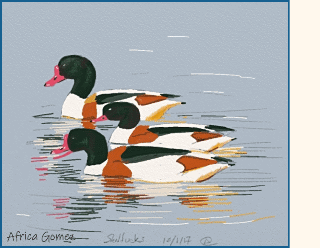
Species Spotlight - Shelduck
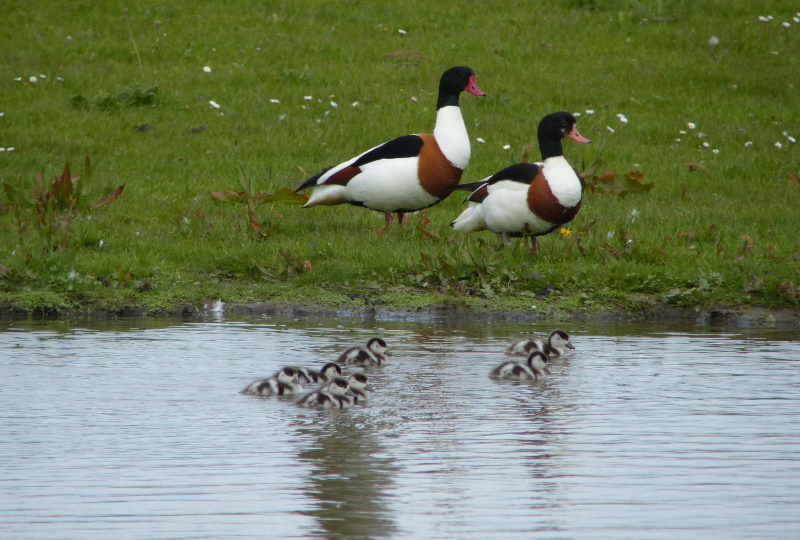
The large and colourful Shelduck is always a joy to
see, being commonplace on the estuary we rather take them for granted
but they really are exotic looking birds. We are lucky as the Dee
estuary and adjacent Mersey estuary are the most important sites in the
country for them.
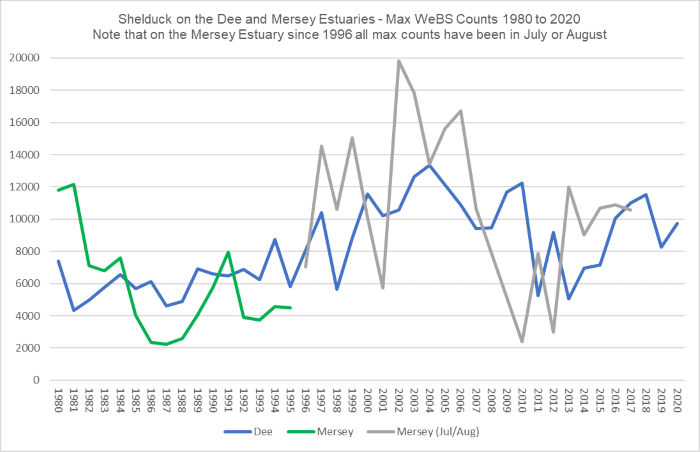
The graph above shows max annual counts (Wetland Bird survey) from the Dee and Mersey estuaries from 1980 to 2020. In the late 1970s and early 1980s the Mersey estuary had more Shelduck than the Dee, at that time numbers peaked on the Mersey during the winter months. But around 1996 there was a dramatic change in their behaviour when large numbers started to use the Mersey estuary as a post-breeding moulting site during July and August, reaching a remarkable 19,810 in August 2002. Shelduck, of course, are famous for their long-distance flight to the Waddensea (mostly to the Helgoland Bight, NW Germany - a straight line distance of just over 470 miles from the Dee estuary) where they moult in July and August. Probably well over half of the UK adult population undergo this flight but a significant number stay to moult in this country mainly in the Humber, the Wash, Firth of Forth and the Mersey - and it is the Mersey which is now by far the most important moulting site in the UK. Numbers moulting on the Mersey do fluctuate quite widely from year to year and are currently at just over 10,000 (there have been some missed and/or partial counts since 2017 so have not been included in the graph - but overall numbers do appear to have dropped in the past three years).
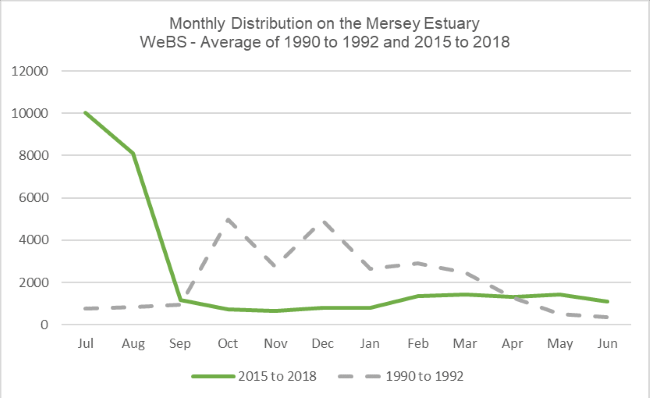
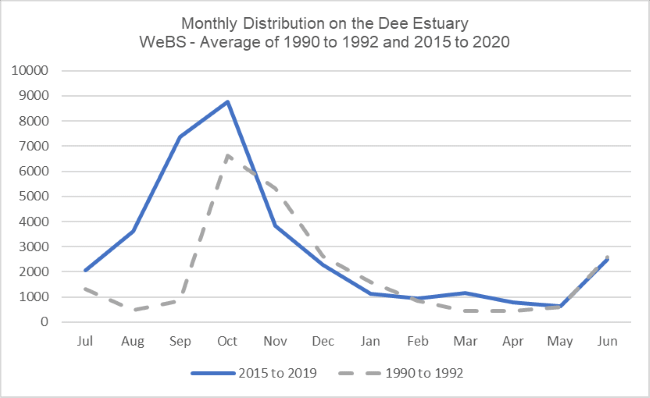
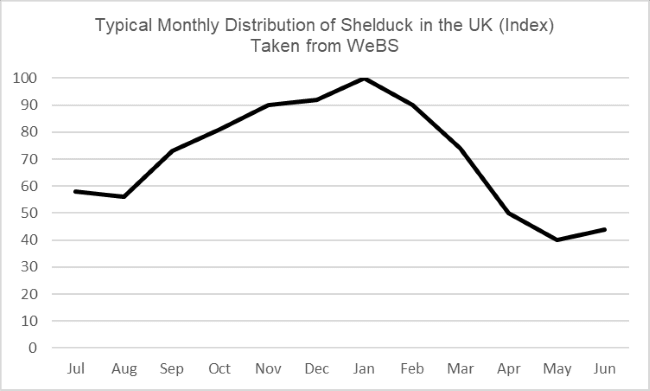
These three graphs, above, tell an interesting
story. I've compared the monthly average in the early 1990s, i.e. pre
1996 and when numbers nationally were high, to the current monthly
distribution. There has been a dramatic change on the Mersey and the
graph shows
the peak numbers which now occur in July and August, compared with
autumn and winter peaks in the early 1990s. Wintering numbers there are
now only around the 1,000 mark, perhaps the moulting flock are
depleting
the food sources which then don't recover until the next summer. On the
Dee estuary the change in distribution is more subtle. The peak on the
Dee estuary has always occurred in autumn so our mudflats must have
plenty of food for birds returning from their moult, whether that's on
the Waddensea or the Mersey. However, before 1996 the peak always
occurred either in October or November whilst since 1996 the peak has
been
either in September or October. Obviously, the reason for the earlier
arrival is
that most birds are now flying the very short distance from the Mersey
to
the Dee after they've finished their moult, rather than several hundred
miles from Germany. Note also, the much higher
numbers that we now have in August on the Dee estuary which suggests
that a few thousand Shelduck moult here as well as on the Mersey,
something which has been suspected for quite a while.
After the October peak birds disperse away from the
Dee very quickly and by January counts are down to 1,000. The monthly
distribution for the UK as a whole is quite different with a peak in
mid-winter, usually in January, and this is presumably when all the
birds which moulted on the Waddensea have returned to the UK. The
movements of Shelduck are complex and by no means fully
understand. The Ribble estuary, just to the north of us, typically has
a peak of around 4,000 but since 2005 this peak has occurred on nine
different months - only excluding April, May and August. I have no idea
what to make of that! Ros Green (BTO), who
has just started a PhD on Shelduck migration (and see Refs 3 and 4),
said "I've got a feeling they do many more interesting things than most
people realise".

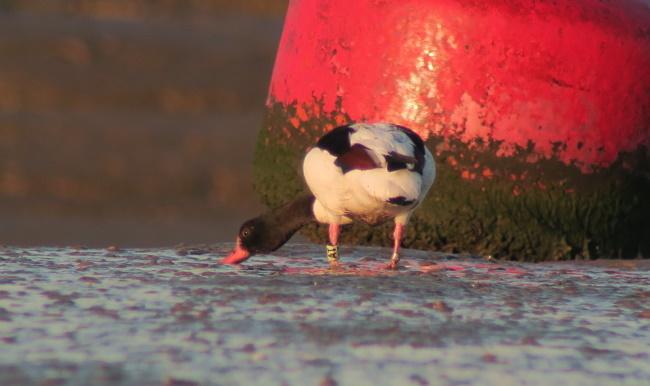
© Richard Smith© Steve Hinde
One way to track these movements is by colour
ringing and a lot of Shelducks have been colour-ringed in recent years,
and on the Dee estuary we have 102 records of 35 colour-ringed Shelduck
over the past three years. Prior to that there have been a total
of four
recoveries of metal ringed birds (which demonstrates just how useful
colour-ringing is), and the map below shows where else all these have
been recorded.

Notes:
1. Over 400 Shelduck have been colour-ringed since
2017 at Martin Mere and we saw our first one on the Dee estuary in
March 2019. Most of these Martin Mere ringed birds are sighted on the
Dee from late August through to early November, after which many spend
the winter back at Martin Mere where they get plenty of free food put
out for the wild swans and captive birds. Typical numbers through the
winter at Martin Mere are around 500. About 30 pairs stay to breed
there but
most have dispersed elsewhere by the end of March, and it is
April when we have seen one or two ringed birds back here on the Dee
Estuary
presumably breeding locally.
2. They have been colour ringing Shelduck in the
Lower Derwent Valley NNR for over 10 years but we didn't see our first
one on the Dee estuary until November 2019. As well as the six birds
seen on the Dee estuary they have also had several other records of
their birds in the north-west of England, so that's an interesting
westwards movement. Like the Martin Mere birds we see these ones in
autumn and spring. There is a sizable breeding population in the
Derwent Valley of at least 60 pairs.
3. A bird ringed at Lower Derwent Valley in February 2018 was spotted at Thurstaston in November 2019, before finding it's way to Zuidhoek, just south of Rotterdam, in February 2021. As far as I can ascertain this is the first ringed Shelduck seen on the Dee estuary which has also been recorded abroad. February is also an interesting date for it to be in the Netherlands, has it been there since moulting on the Waddensea in August, or is it a bird that winters in the UK and breeds on the continent? These are the sort of questions that we hope colour ringing will eventually answer.
Where to see Shelduck on the Dee Estuary

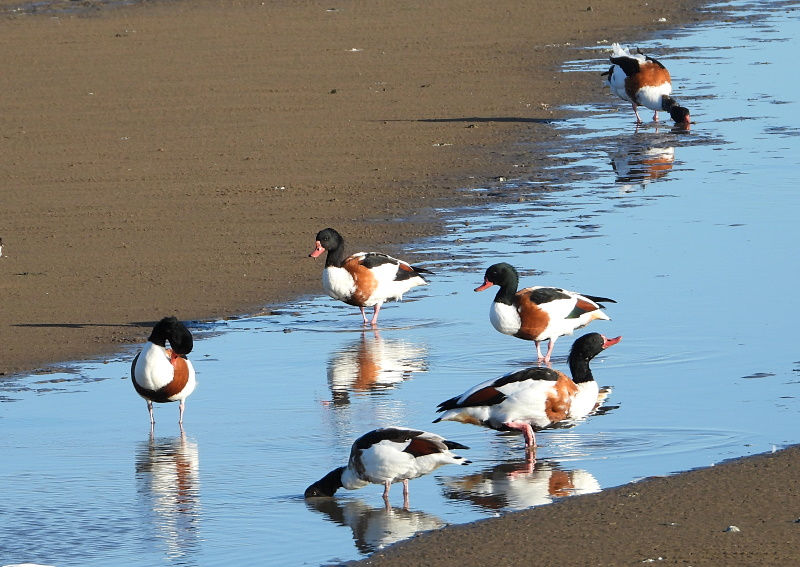
Stand on top of Thurstaston cliffs at low tide
anytime from late September to around mid-October. You will need a
telescope to scan the vast Dawpool Bank in front of you but it will be
covered in Shelduck, and at that time of year you will almost certainly
be looking at the largest flock in the country. Also at that time of
year Point of Ayr will have several hundred with high tide the best
time to see them floating on the sea in the lagoon.
To get closer views take a walk at low tide anywhere between Heswall and West Kirby and there should always be a few feeding on the mud not too far from the beach. Sometimes you can get up to a hundred drinking from the stream at Tinker's Dell. In the spring you will see them paired up when they can be quite noisy and aggressive towards other pairs. In March, before nesting has started, they can often be seen inland on fresh water, sometimes in single pairs but small groups sometimes assemble on local ponds or floods. Then in May you could get lucky and see a family like in the photo at the top of this article.
By mid-October, when the big flock at Thurstaston
starts to disperse, you can get several hundred on the mud off Meols,
and
if you can get there early before the walkers disturb them you can get
really good views of them close to the promenade. If the sun is shining
you can take some great photos directly without having to set foot on
the mud.

References
1. Cheshire and Wirral Bird Reports 1980 to 2019,
CAWOS.
2. Neil Friswell & Colin E. Wells, Dee Estuary
and North Wirral Foreshore WeBS Annual Reports 2009/2010 to 2019/2020.
3. Ros Green, A migration mystery, BTO News Spring
2021.
4. Ros Green et al., Review of the migratory movements of Shelduck to inform understanding of potential interactions with the offshore wind farms in the southern North Sea, BTO Research Report 718, 2019.
Thanks to Kane Brides (Martin Mere) and Craig
Ralston (Lower Derwent Valley) for providing the Shelduck colour
ringing records.
This article
'Contains Wetland Bird
Survey (WeBS) data from Waterbirds in the UK 2019/20 © copyright and
database right 2021. WeBS is a partnership jointly funded by the BTO,
RSPB and JNCC, in association with WWT, with fieldwork conducted by
volunteers.'
Richard Smith
Colour Ring Report
Having concentrated on Sandwich Terns in both the
August and September Newsletters it's now time to take a look at a
selection of other species.
Lapwing
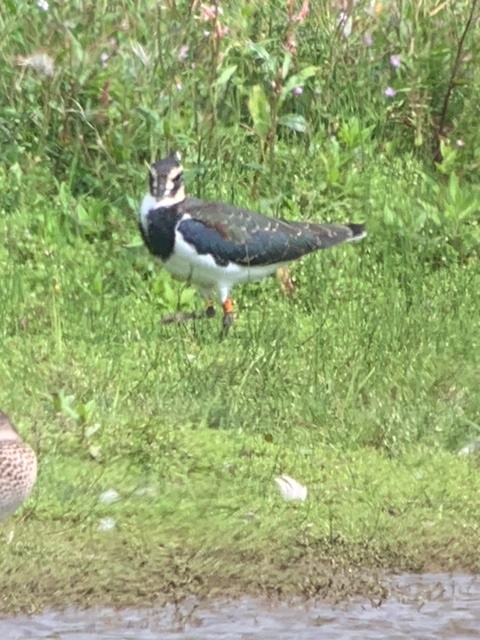
Left Leg: Orange
(C), Right Leg: Yellow (5).
Ringed on 01/05/2021 at Polder Zeldert, near Amersfoort, Netherlands as
a chick.
Recorded at Burton Mere Wetlands RSPB on 25/08/2021.
We see very few colour-ringed Lapwings so it was a good find by Colin Schofield to spot this one. It was ringed in the Netherlands making it even more special.
Oystercatcher
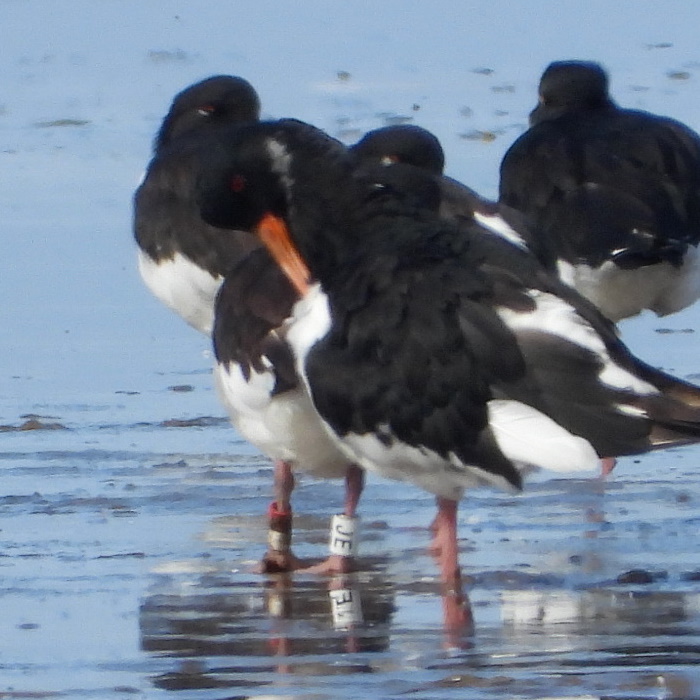
Left leg: Red over White (red ring
partly obscured by mud) Right leg: White (JE).
Ringed on 15/05/2020 at Garour, SW Iceland (just north of Reykjavik
airport) as an adult.
Recorded:
Heysham Harbour, Morecambe Bay, on 30/10/2020.
Hoylake Shore on 10/09/2021.
This is our eighth colour-ringed Oystercatcher from
Iceland where there is currently a lot of work being carried out on
their movements and breeding strategies with some interesting papers
published - it's good to know that we have contributed to something
like this.
Black-tailed Godwits
Since they returned from Iceland in early July we
have had 101 records of 22 colour-ringed Black-tailed Godwits. Quite a
few have been regulars, one of which we've been recording here on the
Dee Estuary every year since 2005 - when it was just two years old. But
below are four interesting ones which we haven't seen before.
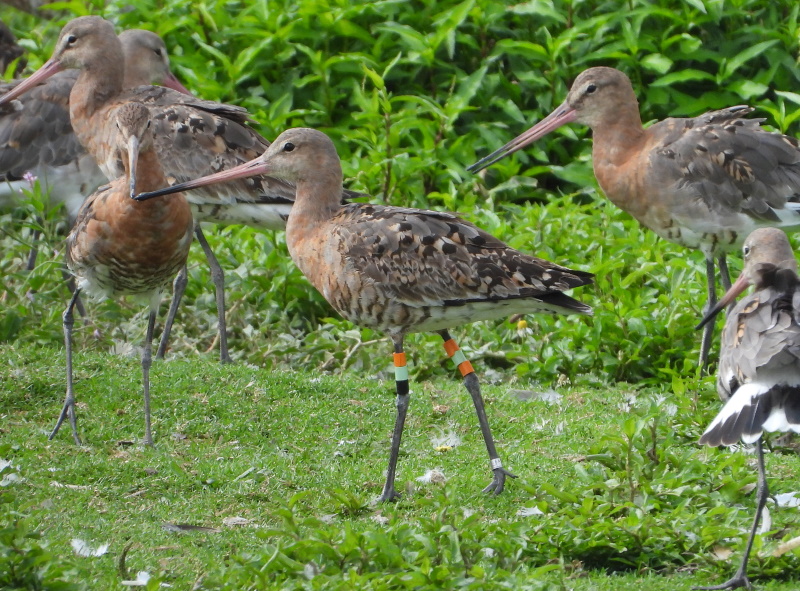
OLN - OLO ringed on 08/10/2018
at Levington on the River Orwell in Suffolk as an adult.
Recorded:
It was in NW Spain then Portugal in the winter of 2018/2019.
The summer and autumn of 2019 saw it back on the River Orwell near
Ipswich before being recorded again in Portugal in February 2020.
It was again back near Ipswich the following summer before being
spotted on the west coast of France in
March 2021 (on the way back from Portugal?).
At Caldy during August 2021.
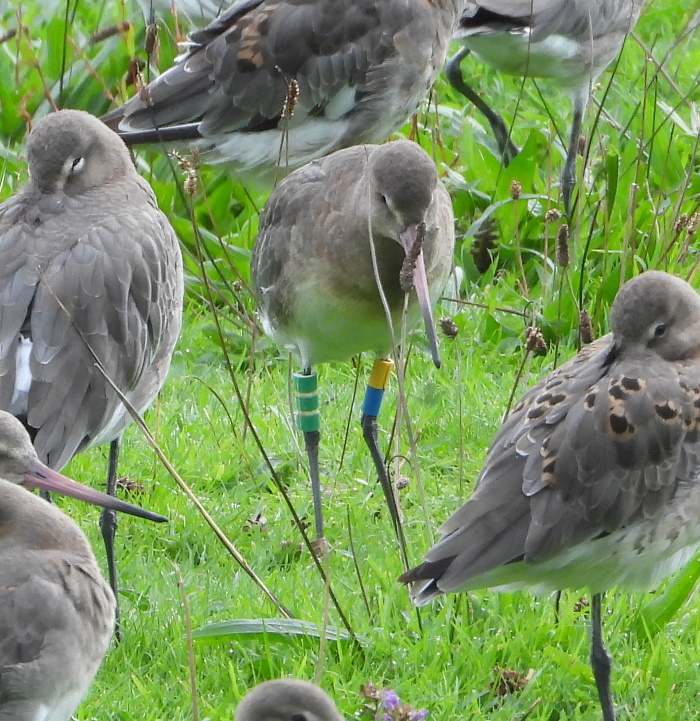
YB-G= ringed
on 24/01/2020 at Bull Island, Dublin Harbour, Ireland, as an adult.
Recorded:
Stiffkey Fen, Cley NNT Reserve and Wells-next-the-Sea all along the
north Norfolk coast in July and August 2020.
It was back in Dublin Bay in January 2021 before returning to north
Norfolk, this time Blakeney, in July 2021.
It was at Caldy on 10/09/21 and it was then recorded on three
consecutive days: 13th Sep at Caldy, 14th Sep at Thurstaston, 15th Sep
in Dublin Bay.
This is the first time we have recorded a Black-tailed Godwit ringed in
Dublin Bay, and YB-G= showed an interesting east to west movement over
the past three months.
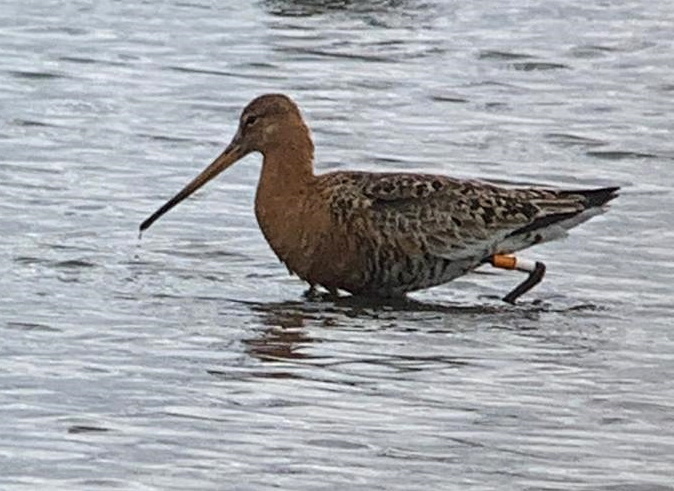
OW-R//W
ringed on 22/08/2005 at Holbeach on the Wash as a juvenile.
Until spotted at Burton in August this bird has never been seen away
from the east coast of England.
It has been recorded a total of 91 times, and every year since 2005.
The sites where it has been seen read like a birder's guide to the best
Nature Reserves in the east of England and include: Breydon Water, Cley
and Welney in Norfolk, Fen Drayton in Cambidgeshire, Saltholme in
Cleveland and Frampton Marsh in Lincolnshire. It has also visited the
Stour Estuary in Essex.
It was at Burton Mere Wetlands on 11/08/2021 but it was obviously in a
hurry to get back to the east coast where it was spotted on the Wash on
13/08/2021.
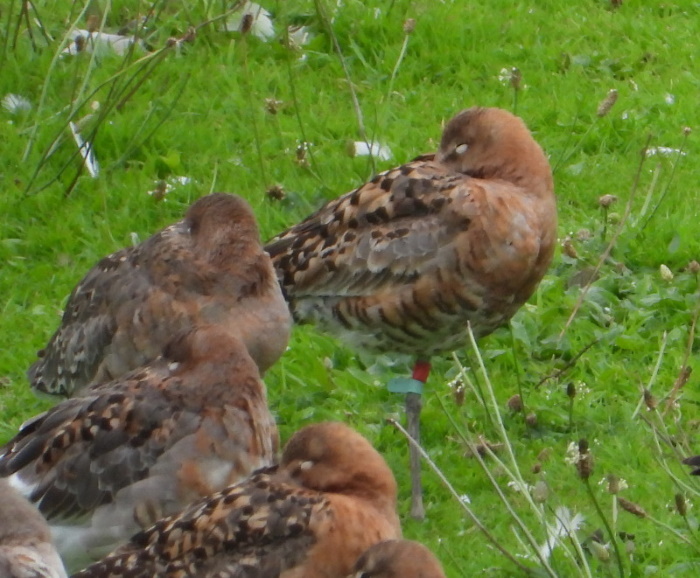
LRLflag - BL
ringed on 07/04/2019 at Irnsum, just south of Leeuwarden, Netherlands.
Recorded on the edge of the Waddensea, Netherlands, in July 2019 and
July 2020. It was at Harlingen, Netherlands, on 20/07/2021 before
moving to Caldy on 08/08/2021. Another interesting east to west
movement. It's presence in the Netherlands in April (when it was
ringed) suggests to me that it winters further south, presumably
France, Portugal or Spain.
This is the first Black-tailed godwit we have seen which was ringed in
the Netherlands, but the following day, 09/08/2021, a second one turned
up which had been ringed at the same site but on 19/03/2021.
Black-headed Gulls

Blue T66H
Ringed on 04/06/2020 at Kornik, Poland, as a chick.
Recorded on 04/08/2021 on Heswall Shore.
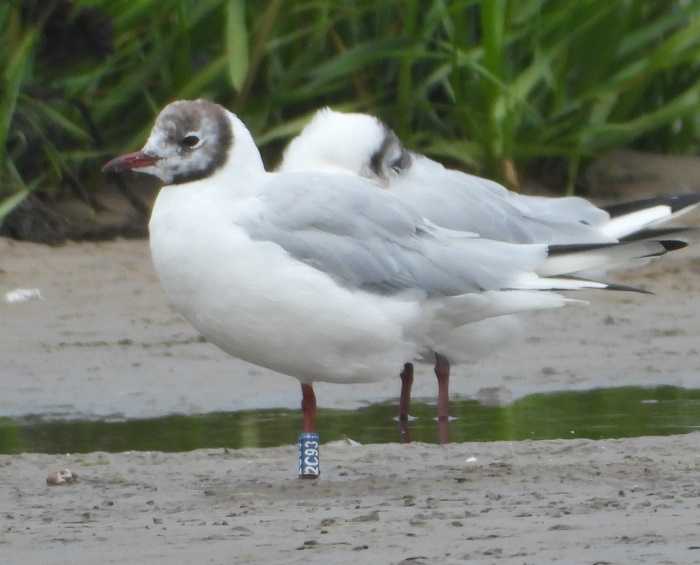
Blue 2C93
Ringed on 11/06/2012 at Killington Reservoir, Cumbria, as a chick.
Recorded:
East Hoyle Bank on 17/09/2014
Hoylake Shore on 14/08/2018
Heysham on 13/02/2019
Meols Shore on 29/07/2021
A rarely seen bird, I wonder where it spends most of it's time?
Colour Rings were recorded by Richard Smith, Colin Schofield, Steve Hinde, Tim Kinch, Chris Williams and Steve Williams.
September Bird News
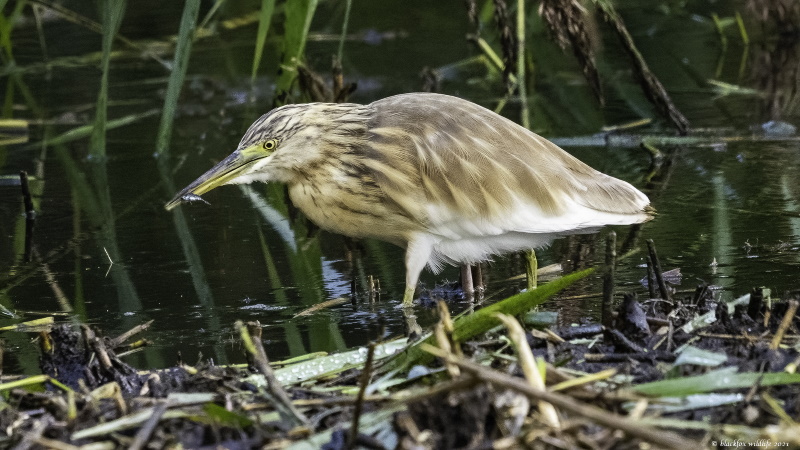
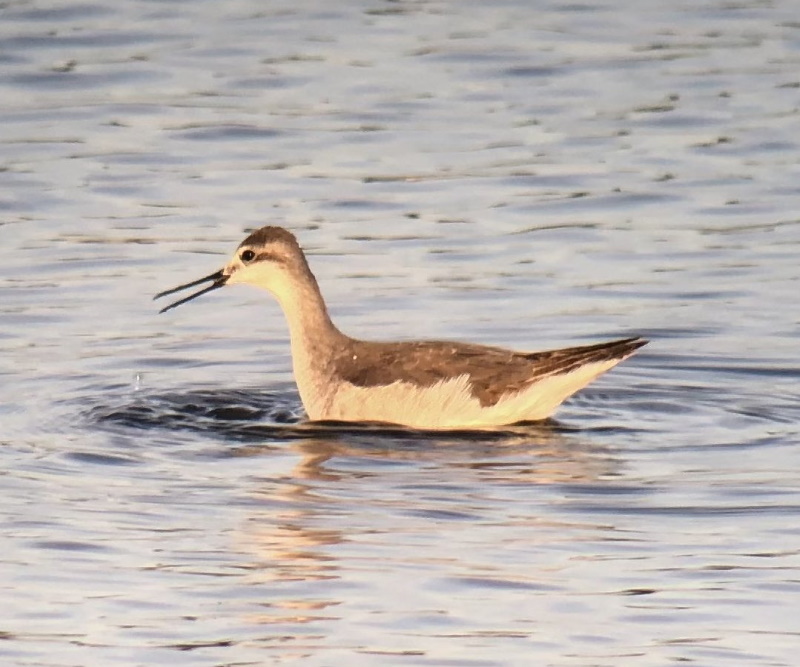
September - a sea bird bonanza it wasn't. Just two
days of strong westerlies which brought in two Leach's Petrels and one
Great Skua, and that was it. There can't have been many Septembers
without a single Arctic Skua recorded!
Plenty of other birds about, though, dominated by
two cracking rarities. A Squacco Heron turned up on the 15th at Big
Pond Wood nature reserve, near Gronant, and was last seen on the 24th.
This is a first for the Dee estuary, the last one anywhere near here
was shot on the River Conwy in 1828! It's normally found around the
Mediterranean and winters south of the Sahara. On the 21st a Wilson's
Phalarope was found mid-morning on the main scrape at Burton Mere
Wetlands, it stayed three days before moving to Parkgate on the 24th,
after which it moved on. For a species which breeds in western Canada
and western USA and winters on salt lakes near the Andes in South
America it has been recorded surprisingly often around the Dee estuary
with a total of eight records since 1978, the last being at Point of
Ayr in Sep and Oct 1997.
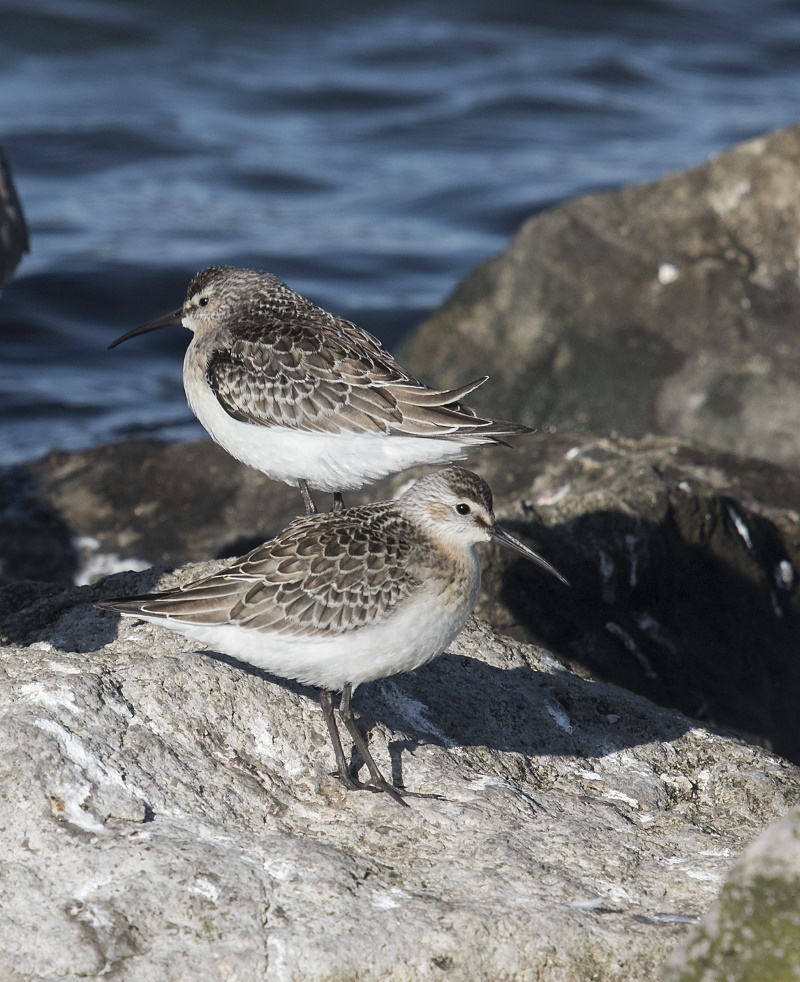
Curlew Sandpipers rather trickled through but a surge of sightings at West Kirby and Heswall in the third week of the month pushed the total number of records to a respectable 58. Seven at both Hoylake on the 12th and at West Kirby on the 18th were the highest counts, but very unusually not a single one at Burton Mere Wetlands. There were also good numbers of Little Stints with at least nine on the shore at Gronant on the 21st easily being the highest count, there were also three at Hilbre and three at Hoylake. On WeBS day (12th Sep) there was a record count of at least 7,728 Black-tailed Godwits, and, remarkably, on the same day there was a record count of 5,138 on the Mersey estuary - that's a lot of Blackwits and is a third of the total British population! Other good wader counts were 7,400 Oystercatchers between Tansky Rocks and Hilbre on the 2nd and 6,240 Redshanks at Heswall on the 6th. Greenshank were at Parkgate all month with a max of 19 on the 7th.
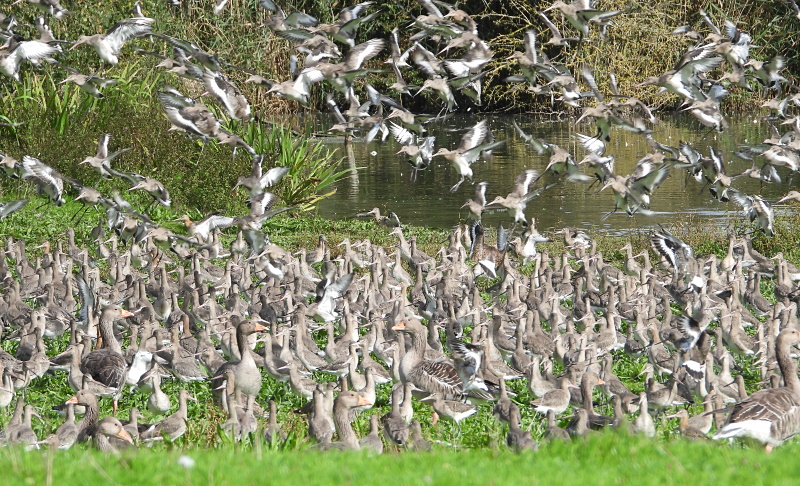
High counts of other species included 1,510 Common
Gulls on the 12th and 5,770 Shelducks on the 20th, both at Heswall.
Five juvenile Spoonbills flew over on the 8th, last seen flying west
from Hilbre, and these must have been in addition to the four already
at Parkgate. 34 Great Egrets and 6 Cattle Egrets were at
Burton Mere Wetlands at the end of the month - expect more in October!
You can certainly expect more Pink-footed Geese in October and several
hundred were already present at the month-end.
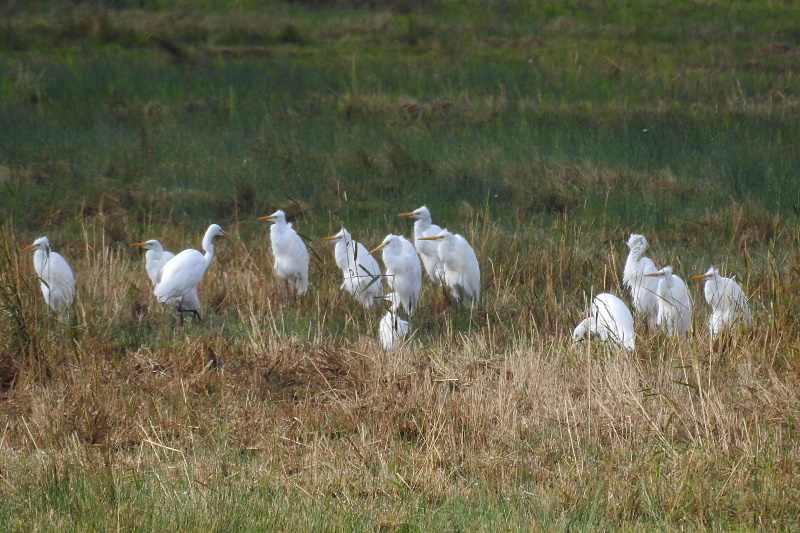
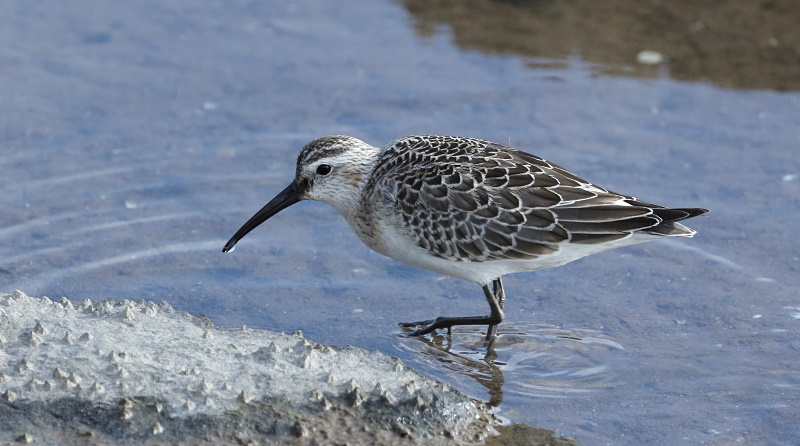
Up to seven fed here for several days, so close you could almost touch them and just below loads of walkers on the lake wall.
What to expect in October
September didn't bring any gales, so lets hope
October is different. It would certainly be nice for some prolonged
strong north-westerlies to coincide with the spring tides on the 7th,
8th and 9th, in which case we should get a good selection of sea birds
including Leach's Petrels, skuas, Sabine's Gulls and Grey Phalaropes.
However, calm weather would not be a complete disaster as it gives us
the opportunity to see the many Common Scoters (could be thousands) and
Great Crested Grebes (100+) which will be on the sea - high tide at
Point of Ayr, Hilbre and north Wirral are the best places to see these.
Gales or not October will be a busy month with many
birds migrating through whilst others are arriving for the coming
winter. Visible migration can be spectacular given the right weather
conditions, a light to moderate south easterly wind, cloud cover and
preferably with some slight morning mist - see Visible
Migration article.
You need to be on the coast at first light to see the best of it and
it can involve hundreds of birds flying along the coast - Chaffinches,
Meadow Pipits, Starlings,
Redwings and Fieldfares are likely to be the most numerous but many
other species can be involved including Siskins.
This month usually sees good numbers of egrets arriving and we may see Cattle Egrets in double figures and Great Egrets are likely to reach at least 30, and 50 + is quite feasible. Pink-footed Geese will be arriving and often we get a few days when thousands are flying over-head over north Wirral on their way to the marshes. Brent Geese are likely to reach over 200 around Hilbre. Duck numbers will be building including Shelduck, Teal, Wigeon and Pintail.
The first of our over-wintering Knot will be arriving hopefully in their thousands whilst we should still be seeing Curlew Sandpipers coming through, in October we usually get them at Burton Mere Wetlands.
We usually see our first Snow Buntings of the winter
this month and look out for rarities such as Yellow-Browed Warblers.
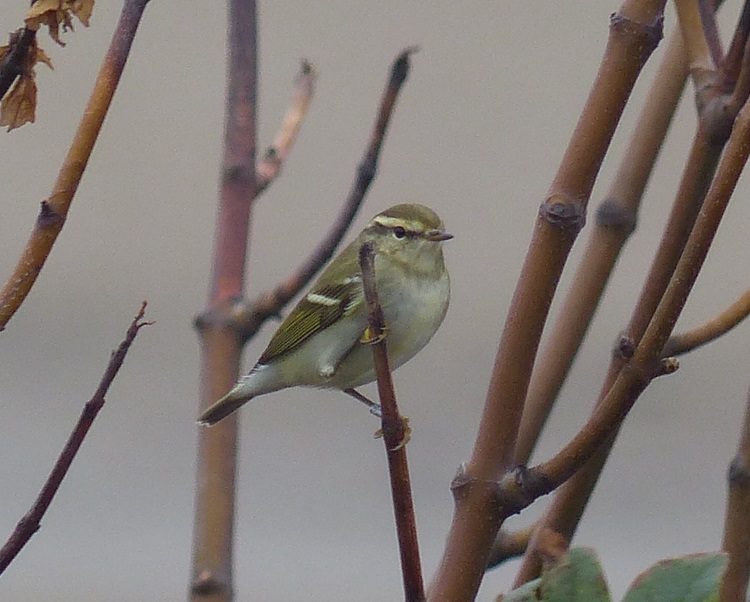
Forthcoming Events
October Highest Spring Tides (Liverpool)
Also see Tides page.
7th October, 12.24hrs (BST), 9.8m.
8th October, 13.03hrs (BST), 9.8m.
9th October, 13.43hrs (BST), 9.7m.